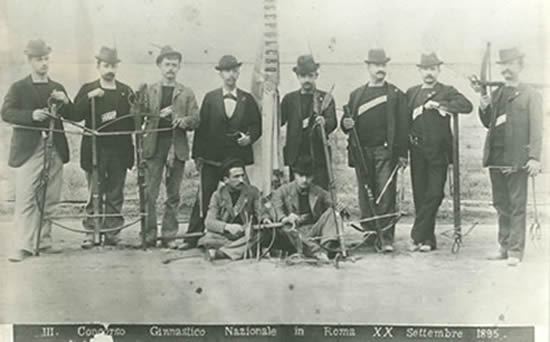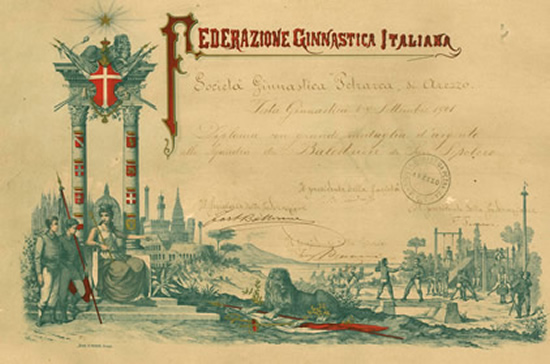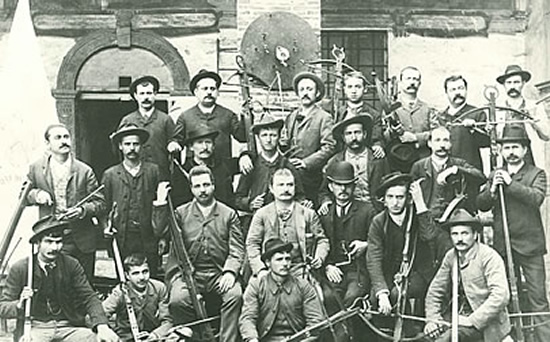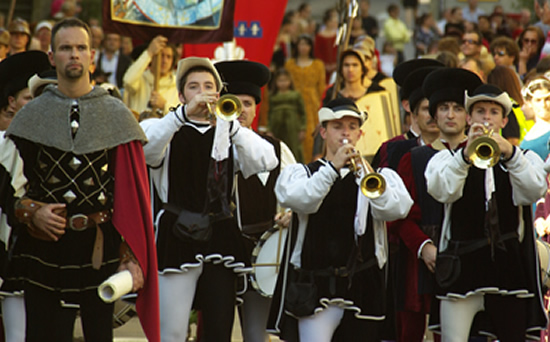Palio della Balestra ®
"WIELD THE CROSSBOW WITH VIRTUE AND HONOUR, AND MAY FORTUNE SMILE ON THE BEST IN THE FIELD"
History of the Palio della Balestra ®
During the Middle Ages and the early Renaissance period, many Italian towns held crossbow shooting competitions to encourage training in the skill for teams of free citizens, which meant there was always a military reserve to defend the city.

The crossbow contest between Sansepolcro and Gubbio is documented since 1594, but there is reliable evidence that it occurred even earlier and, since then, the Palio della Balestra ® has been celebrated every Piero della Francesca himself, the illustrious painter and citizen of Sansepolcro, was theear on the second Sunday in September.
Piero della Francesca himself, the illustrious painter and citizen of Sansepolcro, was the owner of one of the 160 municipal crossbows (his official biography notes that he collected one in 1453 in order to defend his city).
The prize for the winning crossbowman was a quantity of woollen cloth (palio, from the Latin pallium), used to make a robe. .
From the 16th century, crossbows were replaced in battle by firearms, and this kind of competition disappeared everywhere in Italy except in Sansepolcro and Gubbio, where it continued uninterrupted through the centuries, following ancient custom and honouring the cities' patron saints with the contest.
Cosimo de Medici himself attended the event during a visit to the city, and was keen to try his skill with the crossbow.
In 1920 Prince Umberto of Savoy was named honorary president of the Società Balestrieri..
Palio della Balestra ®

The historic contest takes place in the spectacular setting of the Piazza Torre di Berta, flanked by Renaissance palaces.
ccording to ancient custom, the day begins with the town herald declaring the challenge to the rival town of Gubbio. In the afternoon, following a blessing of the weapons, the crossbowmen of the two towns enter the square, announce by a drum roll and clarions, while the flag-throwers display their banners, with the colours of the ancient quarters.
The bowmen of the two towns take turns on the shooting benches, dressed in Renaissance costumes, the silence broken only by the thud of arrows piercing the corniolo (a conical target at a distance of 36 metres); the magic of traditional games is rekindled.

The historic battle between the crossbowmen of Sansepolcro and Gubbio has taken place since 1951 on the second Sunday in September in the picturesque setting of Piazza Torre di Berta, flanked by Renaissance palaces. According to ancient custom, the day begins with the town herald declaring the challenge to the rival town of Gubbio.
In the afternoon, following a blessing of the weapons, the crossbowmen of the two towns enter the square, announce by a drum roll and clarions, while the flag-throwers display their banners, with the colours of the ancient quarters.
The bowmen of the two towns take turns on the shooting benches, dressed in Renaissance costumes, the silence broken only by the thud of arrows piercing the corniolo (a conical target at a distance of 36 metres); the magic of traditional games is rekindled.

Relations between Sansepolcro and Gubbio, the only towns where the crossbow has been in use uninterruptedly to this day, have ancient origins and are documented since 1619, when the crossbowmen of Sansepolcro invited those of Gubbio to the palio of S. Egidio, in accordance with ancient custom.
"Many illustrious noblemen hereby warmly invite you to come on the occasion of s. Egidio on the first day of September, to our merry feast, to take part in our custom of crossbow shooting, in which you may compete in the manner which pleases you. We beseech you to do so for the greater glory to the winner, as expert and famous men will come and compete".
The event is the culmination of the cultural acts that make Sansepolcro a genuine Renaissance landmark on Italy's historical reenactment scene.

